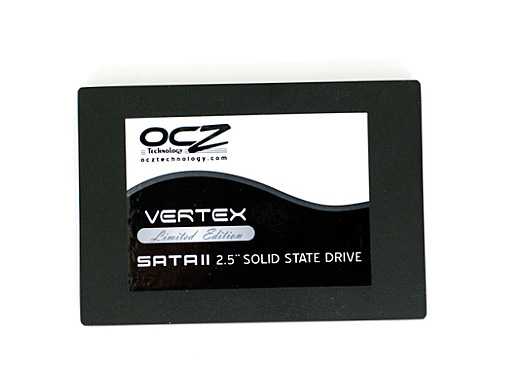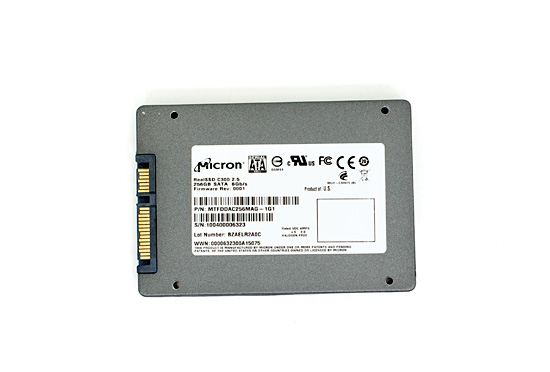OCZ’s Vertex Limited Edition Review & SSD State of the Union
by Anand Lal Shimpi on February 19, 2010 12:00 AM EST- Posted in
- Storage
Final Words
If you were one of the first customers to buy an X25-M G1 or G2, these new drives are fast but not fast enough to make you want to ditch your drive. At the same time, if you’re looking to make the jump to what I’ve often referred to as the single best upgrade you can purchase for your PC, these new drives don’t do anything to lower prices. At $399 the 100GB Vertex LE is no better of a deal than the existing Indilinx offerings. The $499 Crucla RealSSD C300 takes price in the wrong direction as well. If you were waiting for SSDs to get cheaper, you’ll have to wait even longer for the transition to 25nm MLC NAND flash in Q4.
That being said, there is value to be gained from today’s announcement. At $399 you are getting more SSD for your money than you will be able to get when the SF-1200 based Vertex 2 drives ship later this year. The only unknown is how much performance you’ll give up by going to a cheaper SF-1200 drive. I've heard that the maximum read/write speed of the SF-1200 will be similar to the SF-1500, but random performance is unknown at this time. Ultimately how much worse the SF-1200 performs will dictate how valuable the Vertex Limited Edition actually is.

Make no mistake - the Vertex Limited Edition is fast. Easily faster than the SSD posterchild Intel’s X25-M, across the board. It’s only in our heavy multitasking/downloading workload that the SandForce’s controller shows its soft spot. When tasked with a great deal of compressed writes, the SF-1500 controller performs no better than last year’s Indilinx Barefoot. At least with the Vertex LE you’re not paying a price premium for it.
The Vertex LE boasts sequential performance that easily hits the limits of 3Gbps SATA. Doing so with reads isn’t that hard, but with writes it’s harder to do. Granted anything you’re writing that’s large enough to transfer at speeds of 250MB/s for more than a couple of seconds is likely highly compressed to begin with and thus you won’t see those transfer speeds to begin with. Such is the great paradox of SandForce’s DuraWrite technology.
Unlike most drives that only offer good sequential performance, the Vertex LE doesn’t use it as a crutch. Random read and write performance is spectacular, regardless of OS or partition alignment. Under Windows 7, the Vertex LE can randomly write data in 4KB at 162.2MB/s. That’s faster than Intel’s X25-M G2 can write sequentially.
Then we have Crucial’s RealSSD C300, which you are paying a price premium for. Starting at $499 the C300 commands a higher price than any other SSD on the market with 128GB of MLC NAND flash. As a result you get the only 6Gbps compatible SSD on the market, and the performance to back it up.

At first glance it is the most Intel-like of any of the SSDs here. Its performance comes without any stipulations as to the type of writes you have to be doing, it just always delivers.
Sequential and random performance is stellar, although out of the box it doesn’t deliver the best performance under Windows XP. Pair it with a more modern OS that is 4K-aware and its performance easily rivals the SF-1500. Give it access to a 6Gbps SATA controller and it’ll deliver higher sequential read speeds than we’ve ever seen from an SSD.
The RealSSD C300’s random write performance under Windows 7 is slightly behind the Vertex LE, but its random read performance is much better.
Real world performance of the C300 is nothing to scoff at. It’s easily in the top 3 of all SSDs we’ve ever tested, and arguably the fastest MLC SSD on the market. Especially if you pair it with a 6Gbps SATA controller. The only thing that worries me about the C300 is its unusually high max write latency. Admittedly it pokes its head up very rarely and average write latency is second only to the Vertex LE, but OSes don’t always respond well to unexpectedly high write latencies. It’ll be something to keep an eye on as I get more time with the C300.
Our final newcomer is the Kingston SSDNow V+ Series drive. Priced at $399 it continues the trend of not driving prices lower, just offering alternatives. The 128GB drive I tested performed extremely well in some cases such as our heavy multitasking/downloading Bench workload. In others, the drive was much less impressive. The Toshiba controller doesn’t do well in random write performance, mimicking the Samsung RBB controller it often competes with in OEM machines. The fact that I wasn’t able to get TRIM working is also cause for concern. If Kingston could drop the price on the drive and get the TRIM support working it might be an interesting alternative to Samsung based drives.
Now we get to the hard part, recommendation time.
There’s this convergence of SSDs with 128GB of NAND at the $399 price point. Generally at or around $399 you can get something with 128GB of NAND. Controller offerings at this price point are Indilinx, Intel, Samsung and now SandForce.
Assuming the drive is totally reliable, and there’s no chance of any bugs creeping up that OCZ/SandForce missed, the Vertex LE would be the absolute best buy at $399. You’ll notice that my recommendation comes with a huge caveat. The last SF-1500 drive I had died after two weeks. Admittedly it was a beta, but this is also SandForce’s first drive shipping to consumers ever. I think it’s more than fair to be cautious.
If you’re willing to take the risk, the Vertex LE appears to be the best SSD you can buy at $399. It is a difficult proposition simply because we have had such limited experience with the drive and the controller/firmware have a completely unproven track record. It really boils down to how much of an early adopter you are. At least OCZ as a company tends to take care of its customers, so even if you do take the jump and something does go wrong you won’t be SOL. The Vertex LE will ship with a 3 year warranty and if your drive dies you'll get another LE (OCZ is putting some aside), Vertex 2 or other equivalent in its place.
OCZ’s CEO Ryan Petersen and I could always get into another yelling match if you aren’t taken care of.

If you're not willing to risk it, Intel or Indilinx are your best bets. Intel for best random performance, or Indilinx for better sequential write speed and cost.
Go up another $100 and the recommendation is easily the Crucial RealSSD C300. Again, assuming that nothing horrible ever happens with the drive. I do have more faith in Crucial’s validation testing given that Micron is shipping the same drive to OEMs, but it’s still a brand new, unproven platform. It is good to see Crucial/Micron actually embracing new technology instead of shying away from it. The combination of ONFI 2.0 NAND and 6Gbps SATA give the C300 an advantage that no other drive can match.
It's the price point that I'm really not comfortable with. When Intel launched the X25-M at nearly $600, it was fine because no other drive came close. With real world performance of the C300 virtually indistinguishable from the competition, it's difficult to justify that extra $100. Granted in more I/O bound cases, the C300 does have some extra value - I just question whether or not that's worth an extra $100.
While performance is surely improving, price is not. We'll have to wait until Q4 for that. The fact that Intel's roadmaps show the X25-E using 34nm MLC NAND means things are going to get very interesting for enterprise SSDs in 2011.










83 Comments
View All Comments
neoflux - Sunday, February 21, 2010 - link
part number is K9HCG08U1M-PCB00, but still can't find a size in nm.neoflux - Monday, February 22, 2010 - link
Further research shows me that no one knows what manufacturing process size these actually are, which I find strange. No reviews include the information, there are no manufacturing spec sheets, etc. Only that they are lead-free and have 48 pins, haha.This all must makes me more curious. How does no one know?
eldiablopotato - Sunday, February 21, 2010 - link
Both the OCZ & Crucial SSDs are nice, since my motherboard can't do 6Gbps can anyone recommend which SSD to get? I'm thinking Crucial SSD, but then again I'm no expert on SSDs like Anand. :PFeedback welcomed.
nivek - Sunday, February 21, 2010 - link
OCZ says they can't get any more sandforce controllers at a low price point. But how does OWC get the same controller for their Mercury Extreme Enterprise SSD. OWC 100GB SSD is priced the same as OCZ Vertex LE 100GB!http://eshop.macsales.com/shop/internal_storage/Me...">http://eshop.macsales.com/shop/internal_storage/Me...
Per Hansson - Sunday, February 21, 2010 - link
Just curious about the missing capacitor, will there not be a big risk of dataloss incase of power outage?Do you know what design changes where done to get rid of the capacitor, where any additional components other than the capacitor removed?
Because it can be bought in low quantities for a quite ok retail price of £16.50 here;
http://www.tecategroup.com/ultracapacitors/product...">http://www.tecategroup.com/ultracapacitors/product...
sjobal - Sunday, February 21, 2010 - link
Hi Anand,I'm curious to know what SSD is most suitable for a mac. Since OSX does not support TRIM, some sort of garbage collection has to be done within the drive (firmware) or a software tool has to be available for OSX.
Is this something you'll look into in forthcoming reviews?
Best regards!
AnnonymousCoward - Saturday, February 20, 2010 - link
Anand,How can you benchmark in so many different ways, and yet end up with hardly any relevant information? All those PCMark graphs don't tell me squat. Your AnandTech Storage Bench is flawed, since (as your last article found) the SandForce uses compression and IOPS don't equal bandwidth! Why does the user care about IOPS?? Do they care about IOPS of their graphics cards? Or CPU?
With CPUs, you measure things like encoding time and game framerates. Things that matter!
This is the 3rd time I'm posting this. Refer to the last time: http://tinyurl.com/yjcr5vm">http://tinyurl.com/yjcr5vm
Zoomer - Sunday, February 21, 2010 - link
It's a waste of time to do what you're suggesting. The point of SSDs is to improve the user response time.Encoding time? It would likely be virtually identical due to the modern pre-fetching algorithms in place.
Game framerates won't really be affected since the average of 3 runs is taken. After the first run, most everything will be cached, either in hardware or in software by the os in mem.
In the real world, you would expect to see less dips in fps (min fps will be higher), assuming it is a fresh first run.
bradley - Sunday, February 21, 2010 - link
The point is germane. New SSD benchmarks are required to measure real world performance. Some of the current benchmarks end up limited to measuring nothing more than cache speed. IOPS is impractical and demonstrates nothing indicative regarding real world performance.the Problem with Write IOPS - in flash SSDs
http://www.storagesearch.com/problem-write-iops.ht...">http://www.storagesearch.com/problem-write-iops.ht...
erple2 - Sunday, February 21, 2010 - link
Ordinarily, I'd agree with you. However, the point of the article was to point out the problems with "older" benchmarks that would simply look at, in a vacuum, IOPS of a drive was inconsistent at best, and misleading at worst. In the case of Anand's testing methodologies, you see that the IOPS numbers he comes up with are, in fact, the "worst case scenario" listed for SSD's in the article you linked to.Until the giant Meltdown of SSD's in Anand's article (http://www.anandtech.com/storage/showdoc.aspx?i=35...">http://www.anandtech.com/storage/showdoc.aspx?i=35..., testing methodologies that benchmark reviewers were using were definitely perfectly suited to the problems with SSD's, namely the write-erase cycle being specifically excluded from the benchmarks. That indicated the main problem storagesearch.com referred to in the above linked article.
Anand has since changed his benchmark methodology for all SSD's to be a "polluted" SSD - he does not simply wipe the drive clean, then benchmark. He first fills the drive with data, then does a format (which does NOT wipe the drive clean - you still have the write-erase cycle to contend with), then runs benchmarks.
The other thing to look at is that the benchmarks that Anand looks at are, in fact, consistent. Saying that one drive attains 600 IOPS on "Anand's light StorageBench" where another attains 500 IOPS _ON THE SAME BENCHMARK_ does, in fact, give you a reasonably accurate comparison. The trouble you'll get into is if you state "Drive X gets 5000 IOPS, but Drive Y gets 9000 IOPS", not mentioning the actual benchmark used, or even worse, cherry-picking the benchmarks to favor the particular Drive. Then, you have to dig down and figured out whether the benchmarks that gave you "5000 IOPS" was, in fact, properly executed - is that really indicative of the performance of the drive, or only in a very tightly controlled environment to maximize performance numbers? However, that's a question you always have to look at regardless of what you're testing, be it video cards (3D Vantage doesn't give you an accurate picture of how well the card will perform in some particular scenario), CPU's (SPECint or SPECfp give you minimal information about how a CPU performs in a large database environment) or other devices.
So really, I think that the point the article in storagesearch is hammering at you should be wary of reading more into generic IOPS as a benchmark for these SSD's as is simply stated.
So, in conclusion, I disagree about 80% with what you have written.
(minor "edit"):
So I've re-read the GGP post - while it is true that IOPS as a number means nothing to me, it also winds up being true that posting a Bandwidth number would also be more or less worthless to me - what is important is the general ranking of these devices in the same benchmark. The benchmark is measuring the _relative_ performance of each of the drives in the same sequence of tests. Taking conclusions like "this drive gets 600 in a benchmark and that one gets 400 in another benchmark" ultimately fails.
(BTW, Anandtech staff, please fix the fact that I can't use any "rich" text in these posts)